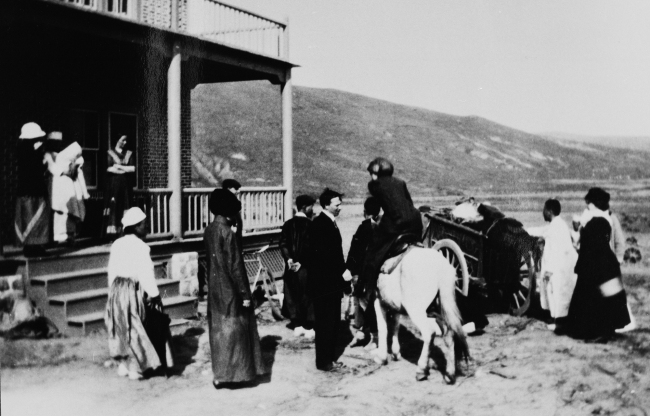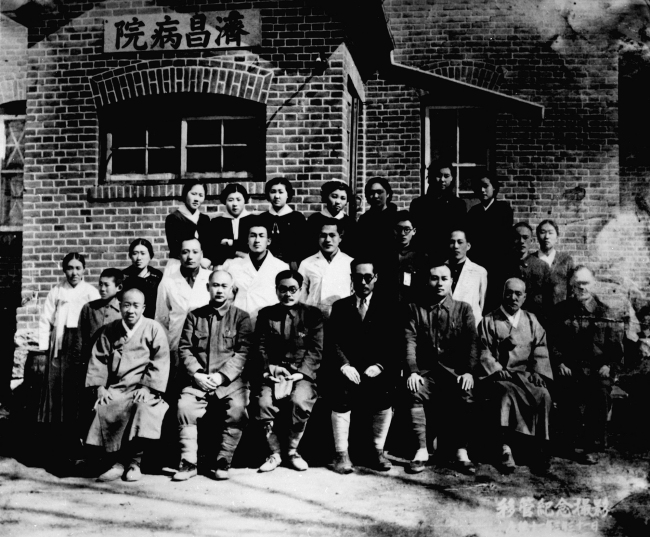[Foreigners Who Loved Korea] Stanley H. Martin, benefactor of the independence movement
Stanley H. Martin, benefactor of the independence movement
By KH디지털2Published : Jan. 25, 2016 - 17:19
In Korea’s turbulent path toward independence and nation building, there were foreign nationals who stood steadfastly by the Korean people, although their contributions have been largely overshadowed by those of Korean patriots. The Korea Herald, in partnership with the Independence Hall of Korea, is publishing a series of articles shedding light on these foreigners, their life and legacies here. This is the eighth installment. ― Ed.
Stanley H. Martin was a medical missionary dispatched to Korea by the Presbyterian Church of Canada. Born in St. Johns, Newfoundland, Canada, he majored in medicine and became a doctor. The missionary doctor Martin was active in Longjing, China and supported the independence movement activities of Koreans, exposing the brutalities of the Japanese imperialists taking place in the Longjing region and taking the side of the weak. Moreover, he devoted himself to eradicating tuberculosis among Korean youths and was a benefactor who truly cared for Korea’s future.
Korea and Martin’s fate
The Presbyterian Church of Canada first sent missionaries to Korea in 1898 and took over the Wonsan Missionary Union of the U.S. Presbyterian Church and was mainly responsible for missionizing in the South Hamgyeong Province and North Hamgyeong Province regions.
Stanley H. Martin was a medical missionary dispatched to Korea by the Presbyterian Church of Canada. Born in St. Johns, Newfoundland, Canada, he majored in medicine and became a doctor. The missionary doctor Martin was active in Longjing, China and supported the independence movement activities of Koreans, exposing the brutalities of the Japanese imperialists taking place in the Longjing region and taking the side of the weak. Moreover, he devoted himself to eradicating tuberculosis among Korean youths and was a benefactor who truly cared for Korea’s future.
Korea and Martin’s fate
The Presbyterian Church of Canada first sent missionaries to Korea in 1898 and took over the Wonsan Missionary Union of the U.S. Presbyterian Church and was mainly responsible for missionizing in the South Hamgyeong Province and North Hamgyeong Province regions.

They established the Seongjin Missionary Union in 1901 and the Hamheung Missionary Union in 1904, gradually expanding areas of their work to Jiandao and the Maritime Province of Siberia after receiving positive responses from the people there. These missionary unions saw the dispatch of medical missionaries paired with missionaries from the Evangelical Church, who founded and operated churches, schools, and hospitals for Koreans in their affiliated regions.
Around 1900, Kim Yak-yeon, Mun Chi-jeong, Gu Chun-seon, Ma Jin, Pak Mu-rim, and other Korean leaders who moved to Longjing, the center of the Jiandao region, converted to Christianity and established churches and schools to contribute to the independence movement.
After Japan’s annexation of Korea in 1910, the churches entered a period of rapid growth. In particular, the pastor who was active in Seongjin, I Dong-hwui, led a Bible study seminar. At this time, based upon the Evangelical Association of the Three Countries of Russia, China, Korea, the movement for the establishment of churches and schools became very active.
Missionaries J. McPherson Scott, A. H. Barker, Macdonald, and Robb were dispatched to the region in fall of 1912 and traveled the area together. They requested the Missionary Union of the Canadian Presbyterian Church to establish a missionary union in Longjing for which they received permission immediately.
Starting with Kim Yak-yeon, Gye Bong-u, and other representatives of each church in the North Jiandao region jointly signed a petition sent to the Canadian Presbyterian Union on Nov. 4, 1912. Its main contents listed as follows: 1) the dispatch of ministers (missionaries) (2) additional dispatch of evangelists (3) and establishing a middle school (4) hospital, etc. Barker and his family moved to Longjing in June 1913 and established a Longjing Missionary Union.

The Martins were appointed to the Longjing branch as medical missionaries in 1916 and began their activities in earnest. Although they first opened a clinic, construction of the hospital building which began in November 1916 was completed in 1918 and the clinic developed into a modern hospital. The newly established St. Andrew Hospital was a modern building outfitted with 30 sickbeds, state-of-the-art with sick wards by gender, an operating room, and a radiology lab. The left side of the hospital’s main building house an outpatient clinic, a male ward on the right side, and behind it a female ward and nurses’ quarters. Besides Martin, the director of the medical team, there were one Korean doctor, two nurses, and one pharmacist, as well as Martin’s wife who was the head nurse. Koreans made up 75 percent of the patients, Chinese 20 percent, and Russians 5 percent.
Supporting the March 1 movement in North Jiandao
The first beginnings of the March 1 Movement in North Jiandao region began not through a liaison with the Korean peninsula but through the links of overseas Koreans in the Maritime Province of Siberia, Russia. Mun Chang-beom, who chaired the Central Association of Russians in Korea, heard that Korean-Americans were struggling with the task of national determination and had appointed a representative to the Paris Peace Conference in December 1918. In response, Mun set off to select a Korean-Russian representative to send to the Paris Peace Conference and gather donations.
Amid these preparations, the March 1 Movement first broke out in Korea. News of the movement reached North Jiandao, and the Korean declaration of independence arrived on the eve of March 7. Then the local representatives of North Jiandao held a secret meeting at Longjing Village and Gukja Street and resolved to hold a celebratory event for the promulgated declaration. The event was scheduled at noon on March 13, 1919 at Seojeon Daeya, downtown Longjing.
At the ceremonial hall was the master of ceremonies Kim Yeong-hak, president, elder Gu Chun-seon, vice president Rev. Bae Hyeong-sik and Korean leaders of the North Jiandao region such as Rev. Kim Nae-beom, evangelist Jeong Jae-myeon, lay deacon Sin Hak-bong, elder Kang Baek-gyu, deacon Ma-jin. After Kim Yeong-hak read the Proclamation of the Declaration of Independence in the name of the Resident Koreans in Jiandao, Yu Ye-kyun, Bae Hyeong-sik, and Hwang Ji-yeong addressed the audience. When the atmosphere was at a high, the demonstrators raised a large banner with the words “Justice and Human Morality,” and broke out into the streets waving taegeukgi, the Korean national flag. Chinese troops, abetted by the Japanese, blocked the demonstrators and fired on them, resulting in many casualties.
On the day of the demonstration, the flag bearer Bak Mun-ho and 12 others died on the spot, and four were fatally wounded and died while being treated in hospital. Eighteen were seriously wounded, and the other wounded numbered 30. All the wounded were moved to the Canadian Presbyterian Missionary St. Andrew’s Hospital. Martin, who supported the Korean independence movement, laid the dead in the basement of the hospital and he and his hospital team did their best to treat the wounded, and even held a joint funeral for those who died.
Following this incident, Martin became even more supportive of the independence movement, and with his help and cooperation, the hospital and its facilities were frequently used by the independence activists as a meeting place and lodgings for those planning for the independence of Korea. It was also where mimeographs of various documents to instill the spirit of independence were printed and circulated. The Jiandao Korean Association, thankful for Martin’s support of the Korean independence movement, gave him a memorial tablet in February 1920.
Publicizing the Jiandao Massacre
In order to subjugate the independence army in Manchuria after the March 1 Movement, Japanese troops invaded Jiandao in October 1920, and committed mass arson and massacres in Korean towns that December. The main force of the Japanese troops was composed of 9,000 of the 19th Army Division and 700 of the 20th Division stationed in Korea respectively, 4,000 from the 14th Division and 1,000 from the 11th Division, and 1,000 from the 13th Division, all three of which were part of the Pojo Army stationed in Vladivostok, 1,000 from the troops stationed in Manchuria, and 1,200 from the Kwantung Army for a total of 18,000-20,000 troops. Surrounding the West and North Jiandao regions in Northeast Asia, their slaughter was a scorched-earth operation.
The number of victims is still unclear, but in the North Jiandao region alone, 3,664 were killed, 155 arrested, and 3,520 houses, 59 schools, 19 churches, and 10.8 million liters of rice was destroyed or lost. The Independence newspaper, published in Shanghai at the time, reported 3,469 killed, 170 arrested, 71 raped, and 3,290 houses, 36 schools, 14 churches, and 9.7 million liters of rice lost.
The arson and massacre by the Japanese troops was a crime against humanity. Despite threats and interference from the Japanese troops, Martin, the head of St. Andrew’s Hospital, visited the scene with his nurses and took pictures of the Japanese massacre and arson on Oct. 31, 1920. He also exposed the true situation of the brutal massacre by the Japanese troops to the world in a report called the “Jangam-dong Massacre,” presenting critical evidence of the cruel and senseless crimes to the world.
Fighting tuberculosis
Martin had been head of St. Andrew’s Hospital until 1927 when he was appointed professor of Severance Medical School and a physician of its hospital, moving to Seoul for his new post. He was head of the Department of Cardiothoracic Surgery and Director of Prevention of Tuberculosis at Severance, particularly focusing on eradicating the chronic disease of tuberculosis among Korean youth. He also contributed his research results to the press or spread them by means of writing or lecturing. Examples of this include “Methods to Diagnose and Treat Tuberculosis” serialized in the Donga Ilbo from Nov. 21-22, 1928 and “On Treatment Methods for Artificial Pneumothorax” presented at the Severance Medical School Alumni Conference on March 24, 1933. In an interview with Donga Ilbo on Jan. 1, he lamented the fact that tuberculosis was prevalent among promising students, and pointed out that its rampant spread was due to “excessive work, unhygienic living conditions, and deficient nutrient intake.”
Then in the fall of 1940, with the clouds of war brewing between the U.S. and Japan, the U.S. and British Consulates strongly recommended that missionaries, particularly the women and children, evacuate. The U.S. government sent The Mariposa to Incheon to evacuate its citizens on Nov. 16, and most of the missionaries and their families, numbering 219, boarded and left Korea. Martin and his wife also evacuated as his wife was an American. Martin died the following year, after returning to Canada.
By Kim Seung-tae
Institute of the History of Christianity in Korea research committee member



















